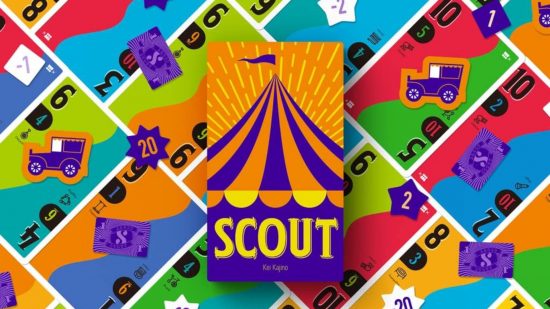Looking for the best card games to play right now? Good news: we’ve tested loads of them to bring you the very best choices in every genre – from snappy 15-minute party games to deep, strategic trading card games. In choosing the best titles, we’ve considered speed and ease of play, tactical depth, compelling themes, and more – so whatever you fancy for your next game night, there’s something to fit the bill here!
These are all distinctive, brand-name card games you can buy from a store. For games with a regular 52-card deck, check out our list of the best playing card games. Or, for a chunkier tabletop experience, try our guide to the best board games.
Why you can trust us ✔ We spend hours testing games, toys, and services. Our advice is honest and unbiased to help you buy the best. Find out how we test.

The best card game for adults overall.
| Publisher | Oink Games |
| Game length | 20 minutes |
| Player count | 2-5 |
| Complexity | 2/5 |
- Unique, innovative rules
- Perfectly balanced gameplay
- Gorgeous, colorful design
- Tough to explain to kids
- Poor use of its theme
Why it’s great
Scout has scooped a bunch of awards and nominations since releasing in 2021, and we think it deserves every single one. Hidden behind its simple premise is a game of careful decision-making. There’s enough strategy and push-your-luck tension packed into this tiny box to fill a whole night of fiendish gaming, but Scout sits at a supremely replayable runtime of just 15 to 30 minutes.
How to play
At first glance, Scout is an easy set-building game, similar to classics like Rummy or Whist. However, Oink Games’ innovations give this familiar gameplay an incredibly unique twist.
Each round, players are looking to collect and play (or ‘Show’) sets of cards with matching numbers or sequential runs. Matching sets always beat sequential runs with the same or fewer cards, and high-value sequences beat low-value ones.
The challenge comes from the fact that, when you first receive your opening hand, you can’t rearrange the order of the cards you were dealt. Your only choice is which way up you’ll play your hand – as both ends have different sets of numbers.
To up the stakes, the set you play must always be more valuable than the one played previously, so sometimes you’ll need to ‘Scout’ cards already played by an opponent – netting you a card that could complete a crucial sequence in your hand, but rewarding another player with a victory point in exchange. The first player to empty their hand or play an unbeatable set ends the round, and they usually take home the most victory points.
Learn more in our Scout review.

Love Letter
The best quick card game.
| Publisher | Z-MAN Games / Asmodee |
| Game length | 20 minutes |
| Player count | 2-6 |
| Complexity | 2/5 |
- Easy to teach
- Rapid, moreish gameplay
- Lovely drawstring bag
- Lacks replayability
- Flimsy cards
Why it’s great
The best card games don’t need to have a weighty deck packed with countless different options to provide a good time. In fact, Love Letter proves that they only need 16. That’s all that’s inside this uber-light, uber-fun classic, which is ideal for the tabletop gamer on a budget (or who’s running low on cupboard room).
Simple to teach and dead easy to jump into, Love Letter makes for a brilliant warmup game. Also, because rounds are so short and cards move around so quickly, you’re never holding the same hidden hand for long, making this that rare thing: a social deduction game that’s still enjoyable for the virtuous among us with no fibbing skills.
How to play
Love Letter has a charming premise. The players are each suitors, trying to send letters to a princess by selecting the right court member as courier, while intercepting their rivals’ wooing efforts.
A single card is dealt to all players, and this represents the person who currently carries your declaration of devotion. Everyone takes turns drawing a card and then playing one from their hand. Depending on which card was played, players may be forced to trade, discard, or add to their hand – or they might be knocked out of the round entirely.
The winner is the last player standing or, if multiple suitors survive, the person with the highest-value card in their hand. Anyone holding the coveted Princess is a surefire winner, but discarding said card can be disastrous for your romantic chances.

The Fox in the Forest
The best trick taking card game.
| Publisher | Renegade Game Studios |
| Game length | 30 minutes |
| Player count | 2 |
| Complexity | 2/5 |
- Simple but engaging
- Dreamy fantasy art style
- Intriguing scoring method
- Unintuitive ‘play to lose’ mechanic
- Lacks theme
Why it’s great
A trick-taking two-player card game, The Fox in the Forest has a lovely fairy tale theme and adorable artwork. However, this cutesiness belies the meaty, satisfying puzzle that lies within. Beneath the surface, this is a fiendish little game about using sneaky tactics to win (and lose) points at just the right time.
How to play
A game of The Fox in the Forest is played across 13 tricks. In each of these, the leading player will lay a card. The following player must then play a card of the same suit, if they can, and any card from their hand if they cannot.
The player with the highest card in the leading suit, or the highest card in the trump suit, determined at the start of the game, wins the trick. The winner then becomes (or remains) the leading player for the next trick.
It’s all about when to expend resources, then, as you want to win tricks by as little as possible, saving your best cards (many of which have special functions) for when you really need them. One very clever rule transforms the experience from enjoyable to exceptional: the scoring mechanism.
You see, you want to win as many tricks as possible, but if you triumph in 10 or more of the 13, you are punished for your greed and don’t win any points. That means at any time, your opponent might switch from trying to best you to trying to throw away winning tricks in spectacular fashion.

Magic: The Gathering
The best trading card game.
| Publisher | Wizards of the Coast |
| Game length | 15 – 120+ minutes, depending on format |
| Player count | 2-6 (more and things get confusing) |
| Complexity | 4/5 |
- Endless strategic variety
- Compelling lore and art
- Superb free digital version
- Collecting can be expensive
- High skill ceiling for newbies
- Very complex advanced rules
Why it’s great
The distinguished paterfamilias of trading card games, Magic: The Gathering sits near the head of the table here for good reason. Simple to learn, but unfathomably difficult to master, Magic is a game with history behind it, one that can be appreciated as much for its beautiful artwork and interesting storytelling as for its tight gameplay and challenging deckbuilding.
The great thing about Magic is the sheer variety of experiences it has to offer, from the constantly shifting Standard meta to Commander’s exciting, over-the-top turns. From lean, mean aggro decks; to infuriating, opponent-stymying control decks; to absurd jank decks that only come together 10% of the time, but when they do are things of beauty; Magic’s a fount of diverse experiences.
How to play
Thanks to the many existing MTG formats, there are multiple ways to play Magic: The Gathering. The basics are always the same, however: you’ll need to construct a deck of cards (between 40 and 100, depending on the format). You’ll then test the strength of your creation against one or more opponents.
Most games are won by reducing your rival’s life points to zero, but there are always alternatives in a game of MTG. Will you steamroll other decks with huge creatures, take them out early with an army of small attackers, or hit them indirectly with other kinds of cards? The choice is yours, and the possibilities are near endless.
This is a pretty complex game, but don’t let this intimidate you. We can teach you how to play Magic: The Gathering in our handy guide, and this list of free MTG Arena codes can help you get started on the game’s digital platform – which we’d argue is one of the most approachable places to learn to play.

Coup
The best social deduction card game.
| Publisher | Indie Boards & Cards |
| Game length | 15 minutes |
| Player count | 2-6 |
| Complexity | 2/5 |
- Addictive bluffing game
- Easy yet engaging rules
- Iconic art
- Social gameplay isn’t for everyone
- A bit too expensive
Why it’s great
Like all great social deduction games, Coup is a delightful ballet of secrets and lies, where the cards you have are far less important than the cards you claim to have. The rules are simple, and games move quickly, but despite this simplicity, Coup is rife with tension. It isn’t the cards that really make the game – it’s staring your opponents in the eye and daring them to take a risk.
How to play
In each game, you’re dealt two cards in secret, each showing a particular member of a backstabbing royal court in a futuristic dictatorship. Every card also has a unique, advantageous ability – or the power to block opponents from using their own abilities.
Someone else may claim to have the Assassin, who gives them the power to remove another player’s card from the game. But what if their target says they have a Contessa, who blocks assassination attempts? This is the crux of Coup’s risky, intoxicating bluffing game.
Any time a claim about a card is made, another player can challenge it. If they were telling the truth, the challenger loses a precious card – but if the challenger outs them as a liar, it’s the first player who must discard. The winner is the last person standing with at least one card, so these are a precious resource to gamble with.
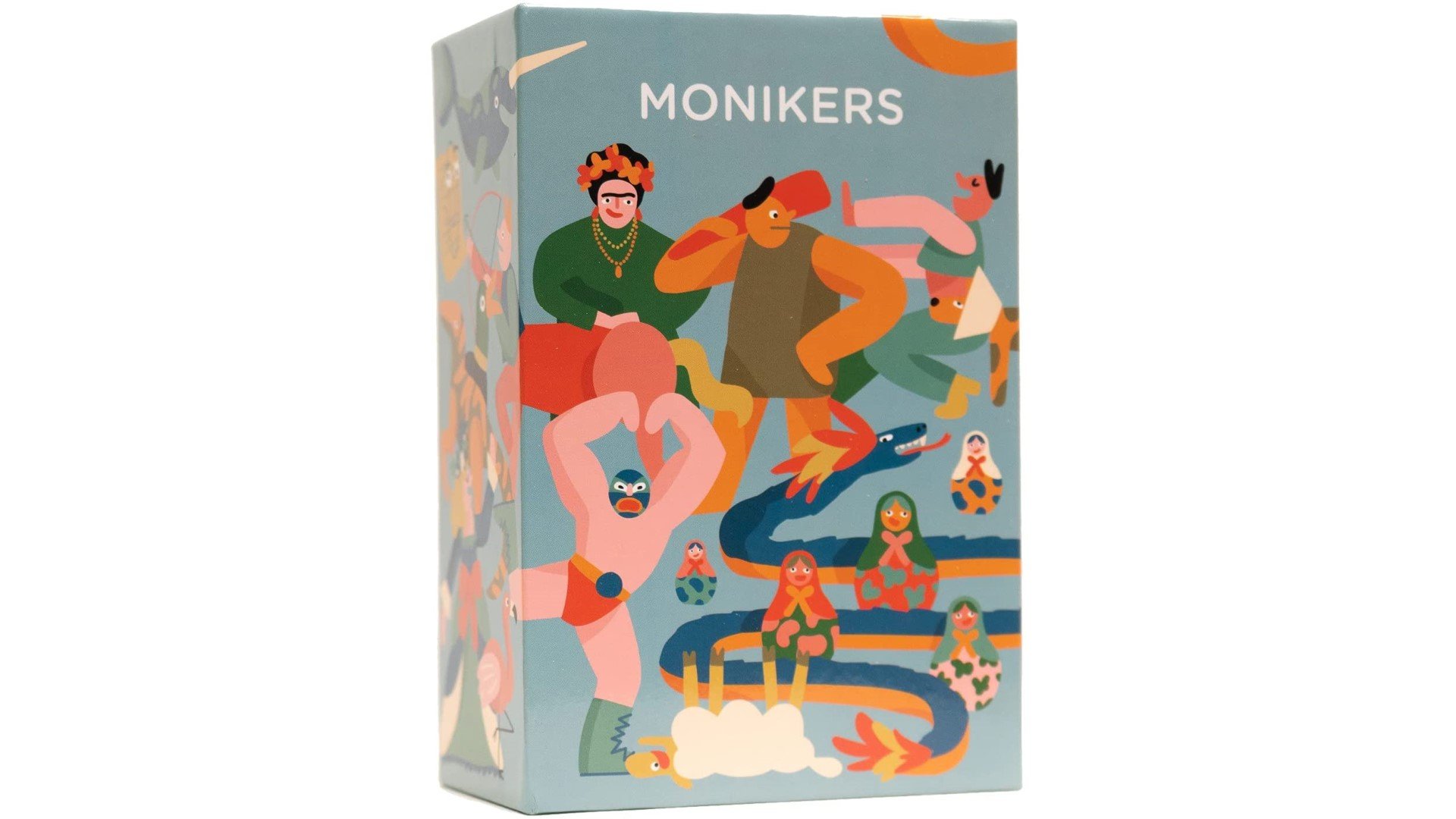
Monikers
The best party card game for adults.
| Publisher | CMYK |
| Game length | 30-60 minutes |
| Player count | 4-16+ |
| Complexity | 1/5 |
- Fast-paced and hilarious
- Easy to learn
- Quality components
- Expensive for what it is
Why it’s great
Monikers may adapt the rules of ancient games like Celebrity and Charades, but it’s one of the most unique – and consistently entertaining – party games around. As easy as it is silly, if your goal is goofy entertainment, there’s no better funny card game for adults.
How to play
In Monikers, players take turns describing a series of characters, objects, or concepts to their team. Cards range from the mundane (Bob Ross, Marie Antoinette) to the seriously outlandish (Doge, Manic Pixie Dream Girl, or just ‘Nobody’).
In the first round, clue-givers can say anything they want, except the phrase on the card they drew. In the second round, they can only utter one word (or noise) for each character, and in the third, they can only mime.
Sounding like an impossible challenge so far? Well, it kind of is. The frustration is half the fun, but the other half comes from the fact that the same deck is used across each of the three rounds, meaning in-jokes form and your group develops a kind of – very silly – shared language.

Dominion
The best deck-building game.
| Publisher | Rio Grande Games |
| Game length | 30 minutes |
| Player count | 2-4 (up to 6 with expansions) |
| Complexity | 3/5 |
- Varied strategic gameplay
- Plenty of quality expansions
- Theme feels old-fashioned
- Expansions can be expensive
Why it’s great
Dominion is the original deck-building game, and it remains one of the best in its genre. Its addictive gameplay loop is made even more enticing by the exhilarating combos you can pull off – and the sneaky ways you can sabotage your friends. Ever varied and short enough to never outstay its welcome, Dominion is replayable even after decades.
There’s plenty of strategic deliciousness to be had just from the core box, but, once you feel you’ve seen what it has to offer, there are no fewer than 15 Dominion expansions on offer, each packed with extra cards that add brand new game features, as well as their own distinct themes.
How to play
In this medieval-themed card game, you and your rivals will all start with identical, small decks of weak cards. You’ll then take turns drawing and playing cards from a central supply to grow, improve, and refine your deck; rack up victory points; and screw over the other players.
That big, central pool of cards contains a whole circus of tricks and treats you’ll need to plot a strategic course between. Some cards straight-up give you victory points; some generate ‘coins’ you can spend on buying new, better cards; some attack your enemies; some let you react to your enemies attacking you; and so on.
Your choices compound, and your chosen deck-building path might outpace your enemies or leave you in their dust. When enough pools of a particular card are empty, the player with the most victory points is crowned the winner.
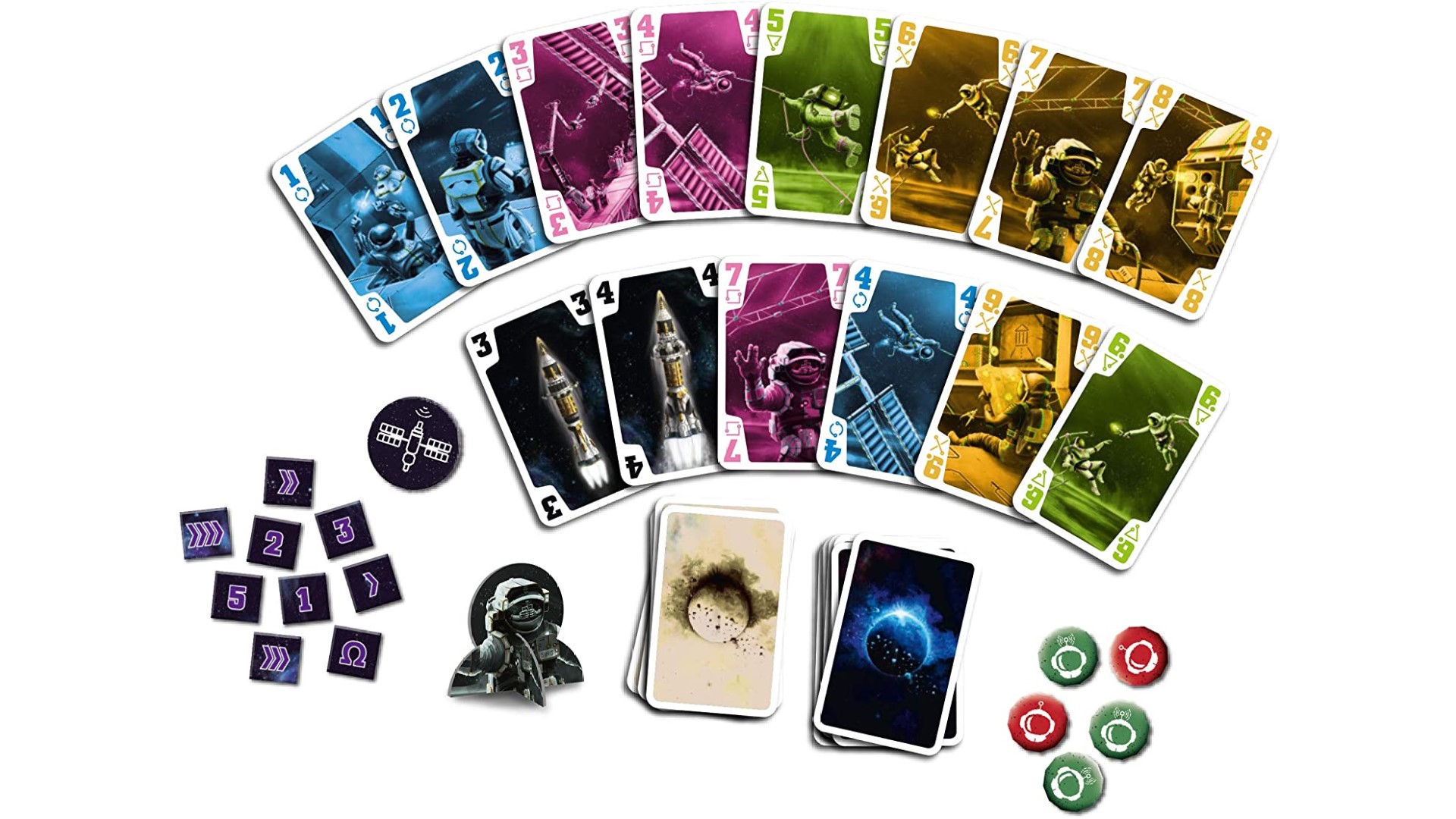
The Crew: The Quest for Planet 9
The best co-op card game for adults.
| Publisher | Kosmos |
| Game length | 20 minutes |
| Player count | 2-4 |
| Complexity | 3/5 |
- Intense coop play
- Good value for money
- You need to play in silence
- Difficulty is high and ramps up fast
Why it’s great
The Crew: The Quest for Planet 9 is fast-paced, tense, and immensely satisfying when your group’s strategy is pulled off. For a simple trick-taking card game – and one that is mostly played in silence – this is high praise.
If it’s up your alley, this space game is out of this world when it comes to value for money. Packed in its compact box you’ll find 50 scenarios, allowing you to change the game up each time, and face increasingly challenging, nightmarish missions.
How to play
Another trick-taking game, but this time cooperative – in The Crew: The Quest for Planet 9, players are astronauts on a mission to the final frontier. To succeed, they’ll need to ensure the right players win the right cards in order to complete individually assigned tasks.
But, uh-oh, a complication! There’s a cosmic communication jam caused by space dust or angry Martians or something, which means you have to play in silence, or at least not discuss strategy. You can only describe your hand to your companions with the help of radio tokens, which indicate whether a card you’ve laid is the highest, lowest or only card of its suit that you’re holding.
That means you really have to pay close attention and get into a shared headspace to figure out what each other’s clues mean. It’s easy to go wrong, but the misunderstandings are usually funny – and you can always yell at your bumbling teammates once the game is complete.
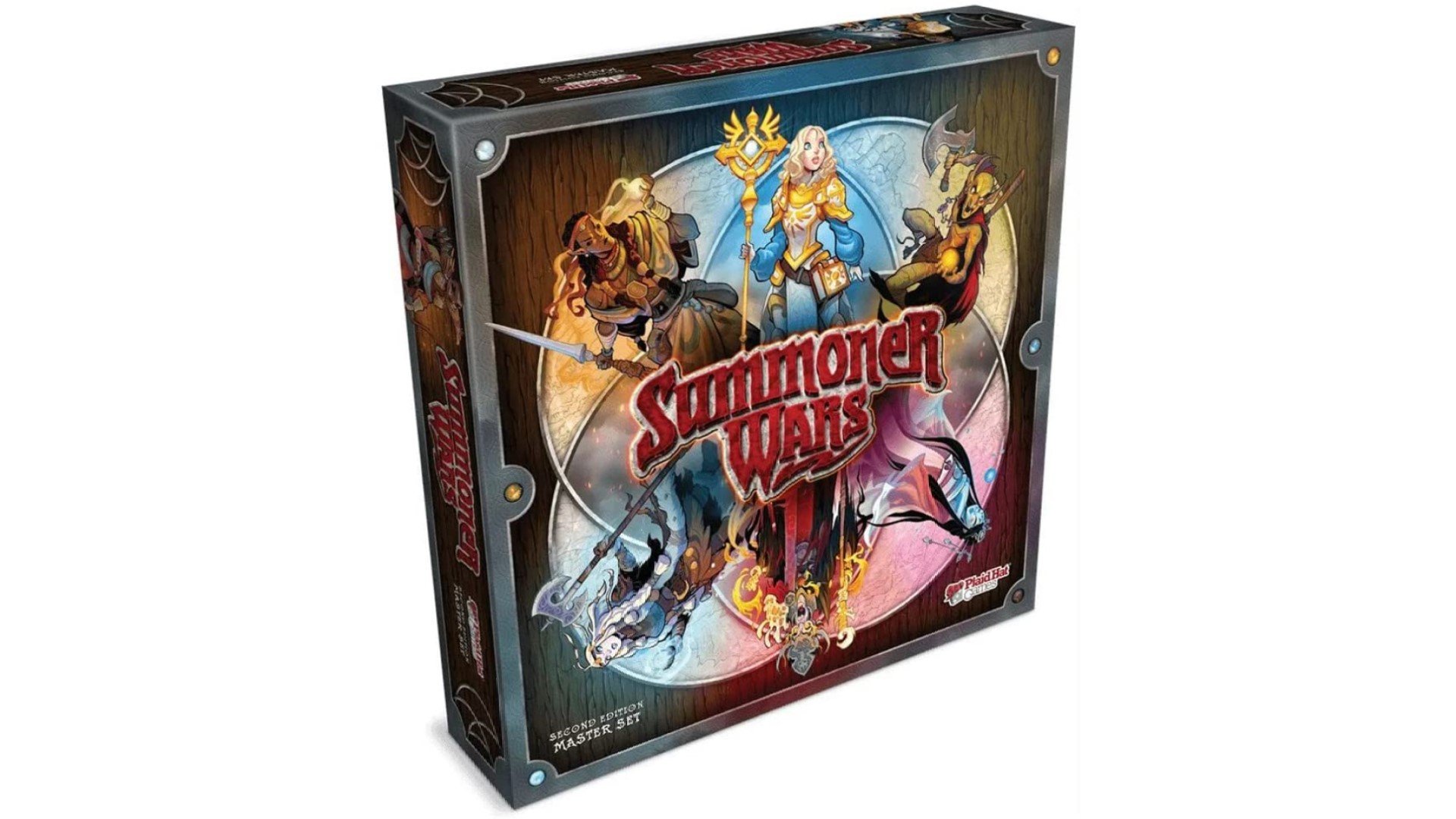
Summoner Wars
The best strategy card game.
| Publisher | Plaid Hat Games / Asmodee |
| Game length | 40-60 minutes |
| Player count | 2 |
| Complexity | 3/5 |
- Excellent expansions
- Accessible but rich strategy
- Divisive, cartoony art style
- Can be quite luck-based
Why it’s great
Summoner Wars is an unusually tactile game of turn-based strategy. Players go head to head in a battle for dominance, adding cards from their unique decks to a shared board and sliding them around in tactical maneuvers. It’s an approachable yet immensely replayable strategy game, and it plays out in far less time than most strategy board games.
Where Summoner Wars really shines is its asymmetrical faction decks, from the boost-based Savannah Elves to the construct-building Polar Dwarves. Each one has its own distinctive playstyle, and with six in the Master Set alone, there are endless memorable matchups to try out.
How to play
Each player places their unique Summoner card on their side of the board, along with any structures or allies that they bring to the battle. Each turn, players draw from their personal deck, and they can move units, initiate combat, or build structures depending on their available resources.
Since cards can only move into adjacent, unoccupied spaces, you’ll need to plan carefully if you want to take over your opponent’s half of the board. The victor is the first to remove their opponent’s Summoner from the field, so combat is a tense, chess-like affair (only with far more ways for luck to screw you over).

Arkham Horror: The Card Game
The best story driven card game.
| Publisher | Fantasy Flight Games |
| Game length | 1-2 hours |
| Player count | 1-2 |
| Complexity | 3/5 |
- Immersive writing
- Fantastic artwork
- Difficult to navigate locations
- Fiddly setup can cause spoilers
- Expensive to add expansions
Why it’s great
Full of co-op (or single-player) adventures, it’s impressive how Arkham Horror: The Card Game creates that big campaign experience using just a few decks of cards. Tweaking the decks that determine your investigators’ powers, equipment and fatal flaws is highly rewarding, and the narratives, though linear, are strongly thematic – with some good twists, turns, and touch choices.
When you tire of fiddling with the core game’s decks and replaying its stories, there are plenty of adventures to be found in expansions – as well as new investigators to try out. That added replayability comes at a cost, but if this Cthulhu-themed game manages to take over your brain, you won’t run out of ways to make it feel new again.
How to play
In Arkham Horror: The Card Game, you play a group of mystery-solving paranormal investigators, finding clues and then figuring out how to deal when those clues sprout tentacles and spiky teeth. Every campaign plays out over several scenarios, each of which plays out depending on your investigators’ skills – and how lucky they are.
Working together, investigators must explore various locations and uncover their secrets to advance the story. Lovecraftian threats lurk around every corner, so players must balance their investigations and fending off eldritch threats. The cards in each player’s hand can be used to improve their investigator’s chances in skill tests and combat – but not every card you pull is a helpful one, and the luck-based chaos mechanics can always interfere with a competent investigator.
In the end, Arkham Horror is a race between the players and the game itself. Gather enough clues, and players will reach the end of the Act deck, netting them a relatively happy ending. However, if they’re not fast or strong enough, the agenda deck will reach its end first and add a grim finale to that chapter of the adventure.
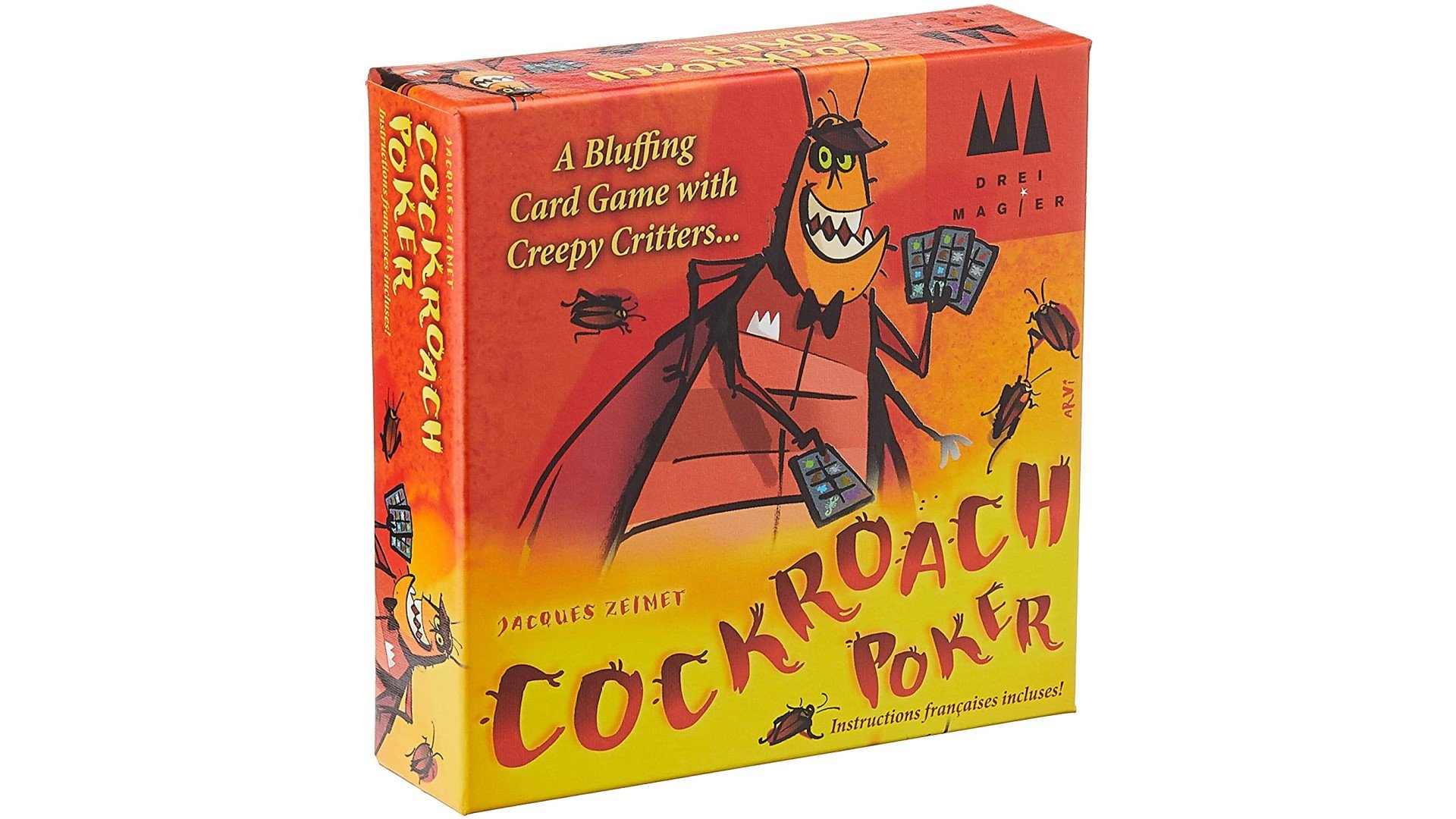
Cockroach Poker
The best pure bluffing card game.
| Publisher | Drei Magier Spiele |
| Game length | 20 minutes |
| Player count | 2-6 |
| Complexity | 2/5 |
- Simple yet elegant gameplay
- Extremely funny
- Slightly ‘yucky’ art style
- Not fun for bad liars
Why it’s great
There’s no better lie than a shared lie, that’s what they say… Or is it? Perhaps we made that up. Anyway, it’s definitely true that the vermin-themed bluffing card game Cockroach Poker (a.k.a. Kakerlaken-Poker in the original German) is stupendous fun. Scout’s honor! It’s absurd, but it’s also absurdly enjoyable.
How to play
Cockroach Poker is all about handing your friend an animal card and, with great audacity, declaring it to be something it isn’t. So you might say a cockroach is a rat, for instance. They can then either make a call on whether you’re lying or not, or pass the card on to the next player.
A correct guess sends the card back to you, but getting it wrong means that player keeps the card instead. If they opt to move the card along, they look at the card first, either agreeing with your claim (“Yes, that’s one whiskery rat all right”) or coming up with a new one, which just like your own, could be true or false (“Actually, it’s a bat!”).
So, you might end up passing a card all the way down the line, until the last player is forced to untangle this web of utter twaddle and settle the matter of what the damn card truly is once and for all. At which point everyone else, who already knew the answer, collapses in a fit of giggles.
The game ends when a player has four of the same card in front of them. In the true spirit of absurdity, there are no winners – just one unfortunate loser with a heap of cards in front of them.

The best push-your-luck card game.
| Publisher | Space Cowboys / Asmodee |
| Game length | 30 minutes |
| Player count | 2 |
| Complexity | 2/5 |
- Simple to learn, fast to play
- Brilliant risk/reward moments
- Cheap and good-looking
- High randomness
- Resetting between rounds gets dull
Why it’s great
Jaipur is a game of risk taking and knowing when to push your luck. It’s a great two-player card game because you soon realize that following your opponent’s moves is more important than planning out your own. You’ve got to get a read on what precious resource they’re collecting, how much of it they’re likely to have, and the size of their camel fleet. And then you can create a plan of action for screwing them over.
As economic card games go, Jaipur is simple but effective. It’s a quick and easy card game to jump into, and incredibly moreish.
How to play
In Jaipur, players are Indian merchants, trading the finest spices, cloth, gold and camels, all in a tug-of-war to become the wealthiest. The overall goal is to collect the most rupees in the best of three rounds. On your turn, you’ve got just two types of moves to consider: you can buy wares, or you can sell them.
While bonuses are awarded for selling goods in large quantities, each type of good decreases in value as the market becomes flooded. That means there’s a fine balance to strike between selling early and waiting till you have more to sell.
You can also buy all the camel cards in one go, which reveals new, valuable resources your foe can snatch up, but gives you greater purchasing power, as you can trade these even-toed ungulates in later for whatever’s sitting on the shelves.
Read our Jaipur review.

Exploding Kittens
The best casual card game for silly fun-times.
| Publisher | Exploding Kittens |
| Game length | 15 minutes |
| Player count | 2-5 |
| Complexity | 1/5 |
- Simple to learn and play
- Fun, tense gameplay
- Jokey, memey art style
- Simple rules can grow dull
- Very random chance driven
- Zero competitive balance
Why it’s great
Ever wished Russian Roulette was a little more family-friendly? Alright, maybe Exploding Kittens is still a pretty grim mental picture – but it’s still a far more family-friendly version of the age-old push-your-luck game. The brainchild of Matthew Inman, creator of webcomic The Oatmeal, this bestselling card game is a direct translation of the comic’s irreverent humor; but it’s still cracking fun even if the jokes aren’t your cup of tea.
Exploding Kittens may seem a bit simple, but the tension as the deck of cards slowly depletes – and the chance of an exploding kitten grows – will leave you breathless. This is one of the biggest-selling board game Kickstarters ever, and the millions of people who’ve picked up a copy can tell you it’s a worthy buy.
How to play
Play is simple. Take turns drawing cards, and the first person to draw an exploding kitten is out. The winner is the last survivor, the one person who managed to avoid encountering spontaneous feline combustion.
Of course, there will be plenty of opportunities to push probability in your favor (or screw an opponent over). Other cards in the deck allow you to check what cards are coming up, force other players to draw cards, or even shuffle the deck entirely – so no one knows where the next exploding kitten will come from.

Air Land & Sea
The best war card game.
| Publisher | Arcane Wonders |
| Game length | 20 minutes |
| Player count | 2 |
| Complexity | 2/5 |
- Quick, tense, and unpredictable
- Plenty of strategic variety
- Newbies will struggle against veterans
- Feels simplistic next to war board games
Why it’s great
With just a handful of cards and very few rules, Air Land & Sea reliably produces nail-biting games, and it plays so quickly it’s incredibly easy to fit in another game – or more. This is a World War Two game (or a cartoon-y ‘Critters at War’ game, if you prefer the alternate theme) that’s fast-paced and exciting for players of all skill levels.
How to play
Three ‘theater’ cards laid out between the players represent the battles for Air, Land, and Sea. Both players start by drawing a hand of cards from a shared deck, representing your forces.
Each card has a strength score from one to six showing how much it contributes to a battle. You can only deploy each card in one type of theater – there’s no way to get your Aircraft Carriers into the battle for the skies – but you can play any card face down into any theater, where it counts as strength two.
You’re fighting to control two out of three battles by having the highest score there at the end of the round, a bit like Marvel Snap. And just like Marvel Snap, your cards have extra powers. They might flip over one of your face-down cards, blow something up, call in reinforcements from the deck, or let you deploy your next unit anywhere. The fact you share the deck with your opponent means you’ll have some idea of what they’ve got in their hand, but you never know.
The best twist is in the scoring system. If you think a round’s going against you, you can choose to retreat. You’ll surrender some points to your opponent, but the sooner you retreat, the less your opponent gets. When should you fold? When do you need to go all in? Can you bait your opponent into the trap you’ve set?

Joking Hazard
The best comedy card game
| Publisher | Cyanide & Happiness |
| Game length | 30-90 minutes |
| Player count | 3-10 |
| Complexity | 1/5 |
- Cards Against Humanity, but better
- Tons of silly, rude webcomic art
- Still relies on crass shock humor
- Perhaps a bit overpriced
Why it’s great
We don’t mean to bag on Cards Against Humanity too much – it was a lot of fun in its day. But we mean it when we say Joking Hazard, from the makers of the Cyanide and Humanity webcomic, is essentially the same experience, only funnier and better. Joking Hazard packs in just as much shock humor as CAH ever did, but this game gets the edge by doing the same simple, dirty, funny thing in a more interesting, creative way.
How to play
Where CAH had players select text-only responses to a shared prompt on a single white card, Joking Hazard creates a three-panel comic strip by selecting panels one and two at random from a pool of 350 cards, then having players propose alternate endings to the strip by playing cards from their hand.
That round’s appointed judge decides the funniest card of all, and players compete in the comedy arena until someone has earned three points. Of course, you could just keep playing until the laughs stop.
At a stroke, this design gives Joking Hazard an extra dimension – pictures – that CAH never had, helping to create more variety between rounds and games by telling a different dumbass story each time. High art it ain’t – but if you and your pals like CAH but have got a bit bored of it, we can heartily recommend this as an alternative.
For more card-based capers, here are the best free card games online that you can play straight away. Or, for date night ideas, here are the best couples’ board games to try.
Not got time or money for a new card game? Whip out your phone instead – our sister site Pocket Tactics can help with the latest links for Coin Master free spins.
Source: Wargamer



